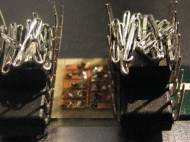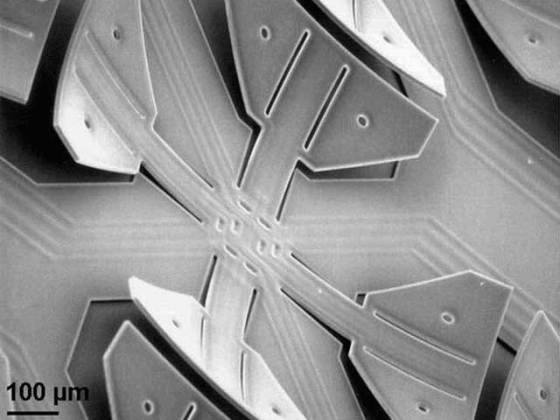Thermally actuated microrobot with omnidirectional walking
 The past few years have given rise to a growing number of microrobots, miniaturized mobile machines designed to perform specific tasks. Researchers at the University of Washington and Stanford University have developed an insect-like robot with hundreds of tiny legs. The robot is able to carry loads more than seven times of its own weight and move in any direction.
The past few years have given rise to a growing number of microrobots, miniaturized mobile machines designed to perform specific tasks. Researchers at the University of Washington and Stanford University have developed an insect-like robot with hundreds of tiny legs. The robot is able to carry loads more than seven times of its own weight and move in any direction.
The microchip, the robot’s body and feet, was first built in the mid 1990s at Stanford University as a prototype part for a paper-thin scanner or printer. A few years later the researchers modified it as a docking system for space satellites. Now they have flipped it over so the structures that acted like moving cilia are on the bottom, turning the chip into an insect-like robot.
The UW’s robot weighs half a gram (roughly one-hundredth of an ounce), measures about 1 inch long by a third of an inch wide, and is about the thickness of a fingernail. It reminds of a centipede, with 512 feet arranged in 128 sets of four. Each foot consists of an electrical wire sandwiched between two different materials, one of which expands under heat more than the other. A current traveling through the wire heats the two materials and one side expands, making the foot curl. Rows of feet shuffle along in this way at 20 to 30 times each second.
The legs’ surface area is so large compared to their volume that they can heat up or cool down in just 20 milliseconds. Researchers were able to pile paper clips onto the robot’s back until it was carrying more than seven times its own weight. This means that the robot could become independent if it carries a battery and a circuit board, since it is currently attached to nine threadlike wires that transmit the power and instructions.
Limbs pointing in four directions allow the robot flexibility of movement in all directions. The chip was not designed to be a microrobot, so there was little effort to minimize its weight or energy consumption. The lead researcher Karl Böhringer, a University of Washington professor of electrical engineering, claims that modifications could probably take off 90 percent of the robot’s weight and eliminate a significant fraction of its power needs.
As with other devices of this type, he added, a major challenge is the power supply. A battery would only let the robot run for 10 minutes, while researchers would like it to go for days. Another problem is its speed, because the UW robot moves a bit less than a meter (3 feet) per hour and it’s far from the slowest in the microrobot pack. If these tiny mobile devices get further development, we could use them to crawl through cracks to explore, collect environmental samples or perform other tasks where small size is a benefit.










Leave your response!